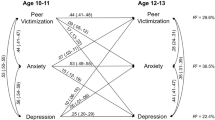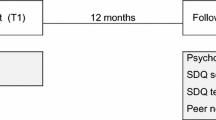Abstract
Use data from the Portuguese HBSC (Health Behaviour in School-Aged Children) survey, which was conducted by one of the authors who is the national representative of the European Study HBSC, a World Health Organisation collaborative study (Currie, Hurrelmann, Setterbulte, Smith, & Todd, 2000; Matos, Simões, Carvalhosa, Reis & Canha 2000), to examine correlates of depression and anxiety in a large, representative sample of adolescents. The study had four aims: (1) to examine the relationship between feelings of anxiety and depression; (2) to examine the association of positive peer relationships, and anxiety and depression in school-age adolescents; (3) to examine the relationship between health, peer relationships, depression and anxiety; and finally, (4) to assess age and gender differences with regard to the above issues. Measures were constructed of depression, anxiety, peer relationships, and health. Consistent with previous studies, anxiety and depression were found to be significantly correlated. A MANOVA revealed that females and adolescents in grades 8 and 10 were more likely to report high anxiety and/or depressive symptoms. High anxiety and depression in adolescence was associated with poor peer relationships and poorer health. Implications of these results and directions for further research are discussed.
Résumé
Pour ce travail nous avons utilisé les données de Health Behaviour in School-Aged Children (HBSC) Survey, étude qui a été conduite au Portugal par un des autheurs, étant la representante nationalle de l’étude Européenne HBSC, une étude de collaboration avec l’Organisation Mondiale de la Santé (Currie, Hurrelmann, Setterbulte, Smith, & Todd, 2000; Matos, Simões, Carvalhosa, Reis, & Canha 2000). Le but de cette étude est d’examimer les correlates de la dépression et de l’anxieté dans un échantillon representatif d’adolescents. L’étude a quatre objectifs: (1) examiner le rapport entre le sentiment de dépression et d’anxieté; (2) examiner l’association entre un rapport social positif avec les copains, et l’anxieté et la dépression chez les adolescents; (3) examiner le rapport entre santé, rapport social avec les copains, dépression et anxieté; (4) évaluer des difference d’âge et sexe a propos des thèmes énoncés. Nous avons contruit des mesures de dépression, anxieté, rapport avec les copains et santé. Dans la même direction que des études antérieures, l’anxieté et le dépression ont été significativement corrélées. Une MANOVA nous a appris que les filles et les adolescents en 8ème et 10ème presentaient plus fréquemment symptômes d’anxieté et de dépression. Anxieté élevée et dépression ont été associées avec un pis rapport social avec les copains et une perception de la santé plus faible. Les implications des résultats de cette étude et la direction d’études futures sont discutés.
Similar content being viewed by others
References
Barefoot, J.C., Helms, J.C., Mark, D.B., Blumenthal, J.A., Califf, R.M., Haney, T.L., O’Connor, C.M., Siegler, I.C., & Williams, R.B. (1996). Depression and long-term mortality risk in patients with coronary artery disease.American Journal of Cardiology, 78, 613–617.
Beidel, D.C., Christ, M.A., & Long, P.J. (1991). Somatic complaints in anxious children.Journal of Abnormal Child Psychology, 19, 659–670.
Boivin, M., Hymel, S., & Bukowski, W.M. (1995). The role of social withdrawal, peer rejection, and victimization by peers in predicting loneliness and depressed mood in childhood.Development and Psychopathology, 7, 765–785.
Boivin, M., Poulin, F., & Vitaro, F. (1994). Depressed mood and peer rejection in childhood.Development and Psychopathology, 6, 483–498.
Cole, D.A., Peeke, L.G., Martin, J.M., Truglio, R., & Seroczynski, A.D. (1998). A longitudinal look at the relation between depression and anxiety in children and adolescents.Journal of Consulting and Clinical Psychology, 66(3), 451–460.
Currie, C., Hurrelmann, K., Setterbulte, W., Smith, R., & Todd, J. (2000).Health and Health behaviour among young people. HEPCA series, WHO, 1.
Egger, H.L., Angold, A., & Costello, E.J. (1998). Headaches and psychopathology in children and adolescents.Journal of the American Academy of Child and Adolescent Psychiatry, 37, 951–958.
Egger, H.L., Costello, J.E., Erkanli, A., & Angold, A. (1999). Somatic complaints and psychopathology in children and adolescents: Stomach aches, musculoskeletal pains, and headaches.Journal of the American Academy of Child and Adolescent Psychiatry, 38(7), 852–861.
Eley, T.C., & Stevenson, J. (1999a). Exploring the covariation between anxiety and depression symptoms: A genetic analysis of the effects of age and sex.Journal of Child Psychology and Psychiatry Review, 40(8), 1273–1282.
Eley, T.C., & Stevenson, J. (1999b). Using genetic analyses to clarify the distintion between depressive and anxious symptoms in children.Journal of Abnormal Child Psychology, 27(2), 105–114.
Essau, C.A., Conradt, J., & Petermann, F. (2000). Fequency, comorbidity and psychosocial impariment of anxiety disorders in German adolescents.Journal of Anxiety Disorders, 14(3), 263–279.
Fergusson, D.M., Horwood, L.J., & Lynskey, M.T. (1993). Prevalence and comorbidity of DSM-III-R diagnoses in a birth cohort of 15-year-olds.Journal of the American Academy of Child and Adolescent Psychiatry, 32, 1127–1134.
Fordham, K., & Stevenson-Hinde, J. (1999) Shyness, friendship quality, and adjustment during middle childhood.Journal of Child Psychology and Psychiatry and Allied Disciplines, 40(5), 757–768.
Frasure-Smith, N., Lesperance, F., Juneau, M., Talajic, M., & Bourassa, M.G. (1999). Gender, depression, and one-year prognosis after myocardial infaction.Psychosomatic Medicine, 61, 26–37.
Harter, S., & Whitesell, N.R. (1996). Multiple pathways to self-reported depression and psychological adjustment among adolescents.Development and Psychopathology, 8(4), 761–777.
Herman-Stahl, M., & Peterson, A.C. (1996). The protective role of coping and social resources for depressive symptoms among young adolescents.Journal of Youth and Adolescence, 25(6), 733–753.
Joiner, T.E., Blalock, J.A., & Wagner, K.D. (1999). Preliminary examination of sex differences in depressive symptoms among adolescent psychiatric inpatients: The role of anxious symptoms and generalised negative affect.Journal of Clinical Child Psychology, 28(2), 211–219.
Kovacs, M., & Devlin, B. (1998). Internalizing disorders in childhood.Journal of Child Psychology and Psychiatry, 39(1), 47–63.
Kupersmidt, J.B., & Patterson, C.J. (1991). Childhood peer rejection, aggression, withdrawal, and perceived competence as predictors of self-reported behaviour problems in preadolescence.Journal of Abnormal Child Psychology, 19(4), 427–449.
Lewinsohn, P.M., Rohde, P., & Seeley, J.R. (1998). Major depressive disorder in older adolescents: Prevalence, risk factors, and clinical implications.Clinical Psychology Review, 18(7), 765–794.
Livingston, R., Taylor, J.L., & Crawford, S.L. (1988). A study of somatic complaints and psychiatric diagnosis in children.Journal of the American Academy of Child and Adolescent Psychiatry, 27, 185–187.
Matos, M.G. (1997).Comunicação e gestão de conflitos na escola. Lisboa: CDI FMH.
Matos, M.G., & Carvalhosa, S.F. (2001). Violência na escola: Vitimas, provocadores e outros.Aventura Social & Saúde,2(1), FMH.
Matos, M.G., Simões, C., & Carvalhosa, S.F. (2000).Desenvolvimento de competências de vida na prevenção do desajustamento social. Lisboa: IRS/MJ.
Matos, M.G., Simões, C., Carvalhosa, S., Reis, C., & Canha, L. (2000).A Saúde dos jovens Portugueses, Lisboa: PEPT/GPT/FMH.
McGee, R., Feehan, M., Williams, S., & Anderson, J. (1992). DSM-III disorders from age 11 to age 15 years.Journal of the American Academy of Child and Adolescent Psychiatry, 31, 50–59.
Ohannessian, C.M., Lerner, R.M., Lerner, J.V., & von Eye, A. (1996). Does self-competence predict gender differences in adolescent depression and anxiety?Journal of Adolescence, 22(3), 397–411.
Oldehinkel, A.J., Wittchen, H.U., & Schuster, P. (1999). Prevalence, 20 month incidence and outcome of unipolar depressive disorders in a community sample of adolescents.Psychological Medicine, 29(3), 655–668.
Pine, C.S., Cohen, P., & Brook, J. (1996). The association between major depression and headache: Results of a longitudinal epidemiologie study in youth.Journal of Child and Adolescent Psychopharmacology, 6, 153–164.
Rauste-von Wright, M., & von Wright, J. (1981). A longitudinal study of psychosomatic symptoms in healthy 11–18 year old girls and boys.Journal of Psychosomatic Research, 25, 525–534.
Raymer, D., Weininger, O., & Hamilton, J.R. (1984). Psychological problems in children with abdominal pain.Lancet, 1, 439–440.
Roberts, C., François, Y., Batista-Foguet, J., & King, A. (2000). Methods. In C. Currie, K. Hurrelmann, W. Settertobulte, R. Smith, & J. Todd (Eds.),Health and Health bebaviour among young people. HEPCA series, WHO, 1., pp. 11–23.
Rudolph, K.D., & Hammen, C. (1999). Age and gender as determinants of stress exposure, generation, and reactions in youngsters: A transactional perspective.Child Development, 70(3), 660–677.
Rudolph, K.D., Hammen, C., & Burge, D. (1997). A cognitive-interpersonal approach to depressive symptoms in preadolescent children.Journal of Abnormal Child Psychology, 25(1), 33–45.
Schraedly, P.K., Gotlib, I.H., & Hayward, C. (1999). Gender differences in correlates of depressive symptoms in Adolescents.Journal of Adolescent Health, 25, 98–108.
Spence, S. (1998). A measure of anxiety symptoms among children.Behaviour Research and Therapy, 36(5), 545–566.
Walker, L.S., & Greene, J.W. (1989). Children with recurrent abdominal pain and their parents: More somatic complaints, anxiety, and depression than other patient families?Journal of Pediatric Psychology, 14, 231–243.
Wentzel, K.R., & McNamara, C.C. (1999). Interpersonal relationships, emotional distress, and prosocial behavior in middle school.Journal of Early Adolescence, 19(1), 114–125.
Woodward, L.J., & Fergusson, D.M. (1999). Childhood peer relationships problems and psychosocial adjustment in late adolescence.Journal of Abnormal Child Psychology, 27(1), 87–104.
Author information
Authors and Affiliations
Additional information
The HBSC study in Portugal in 1996/2002 was funded by Projecto VIDA, by Gabinete de Prevenção da Toxicodependência/CM Lisboa, CNLCSida and FCT/MCT/37486/PSI/2001.
Rights and permissions
About this article
Cite this article
de Matos, M.G., Barrett, P., Dadds, M. et al. Anxiety, depression, and peer relationships during adolescence: Results from the Portuguese national health behaviour in school-aged children survey. Eur J Psychol Educ 18, 3–14 (2003). https://doi.org/10.1007/BF03173600
Received:
Revised:
Issue Date:
DOI: https://doi.org/10.1007/BF03173600




